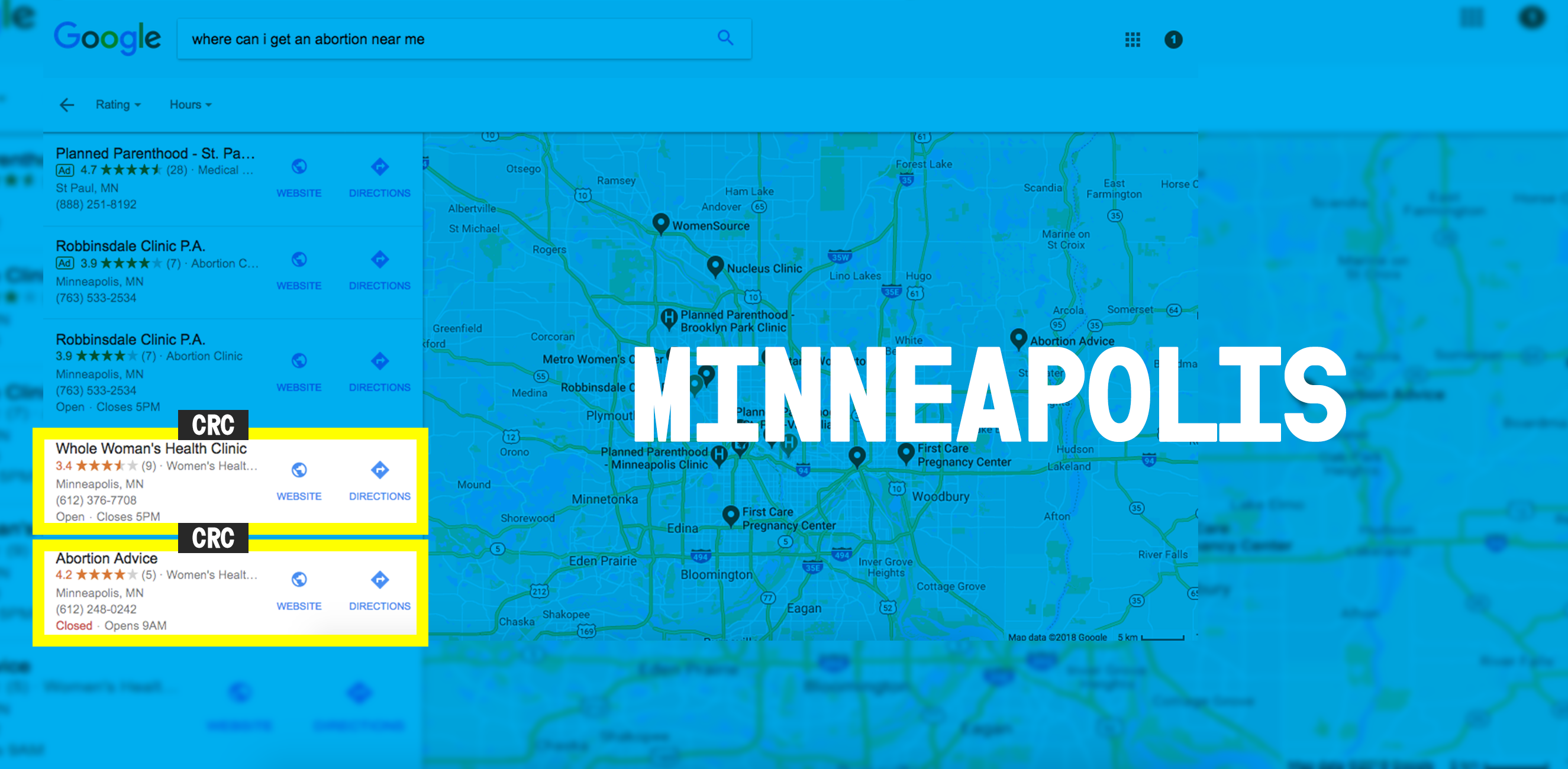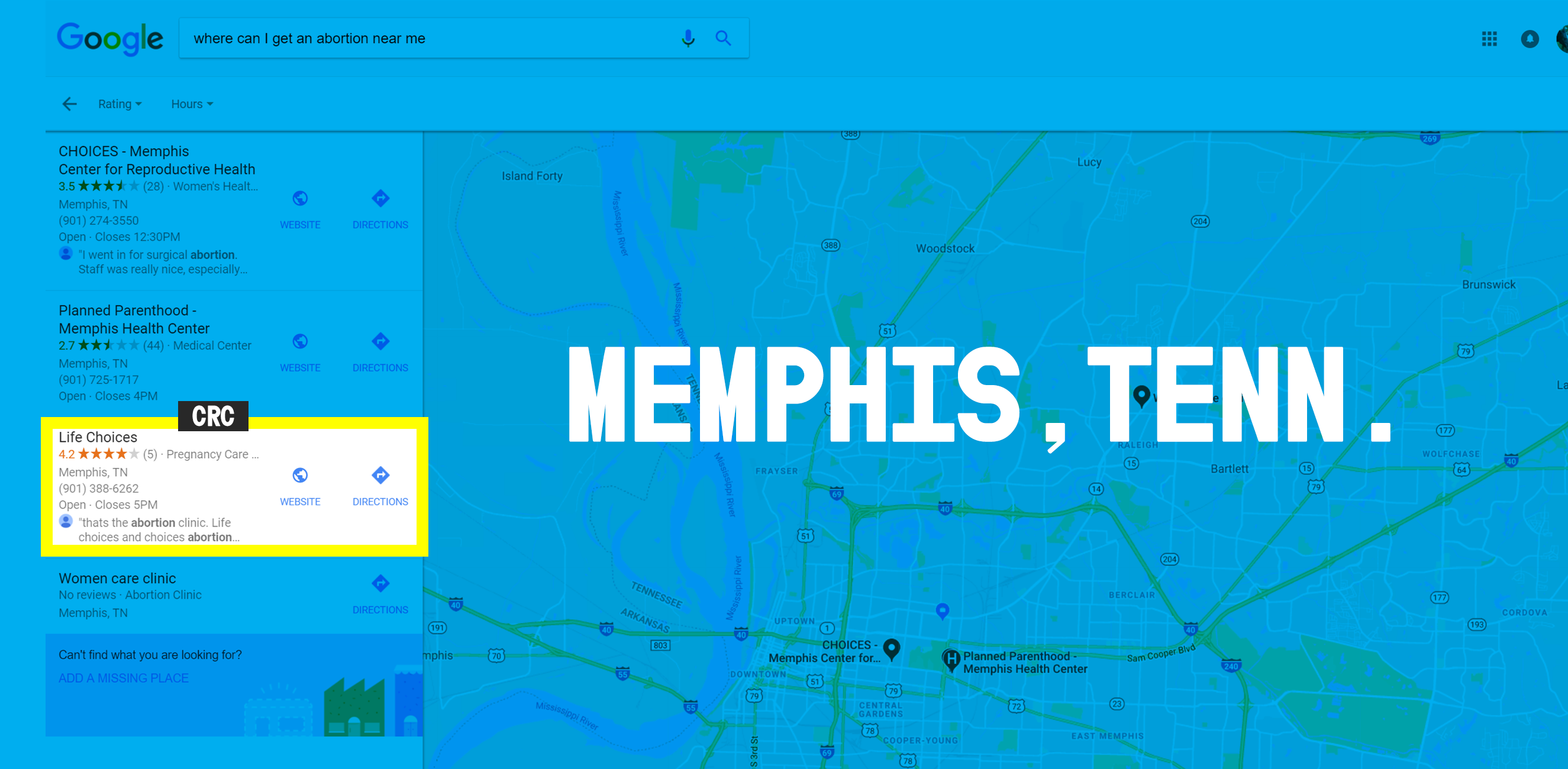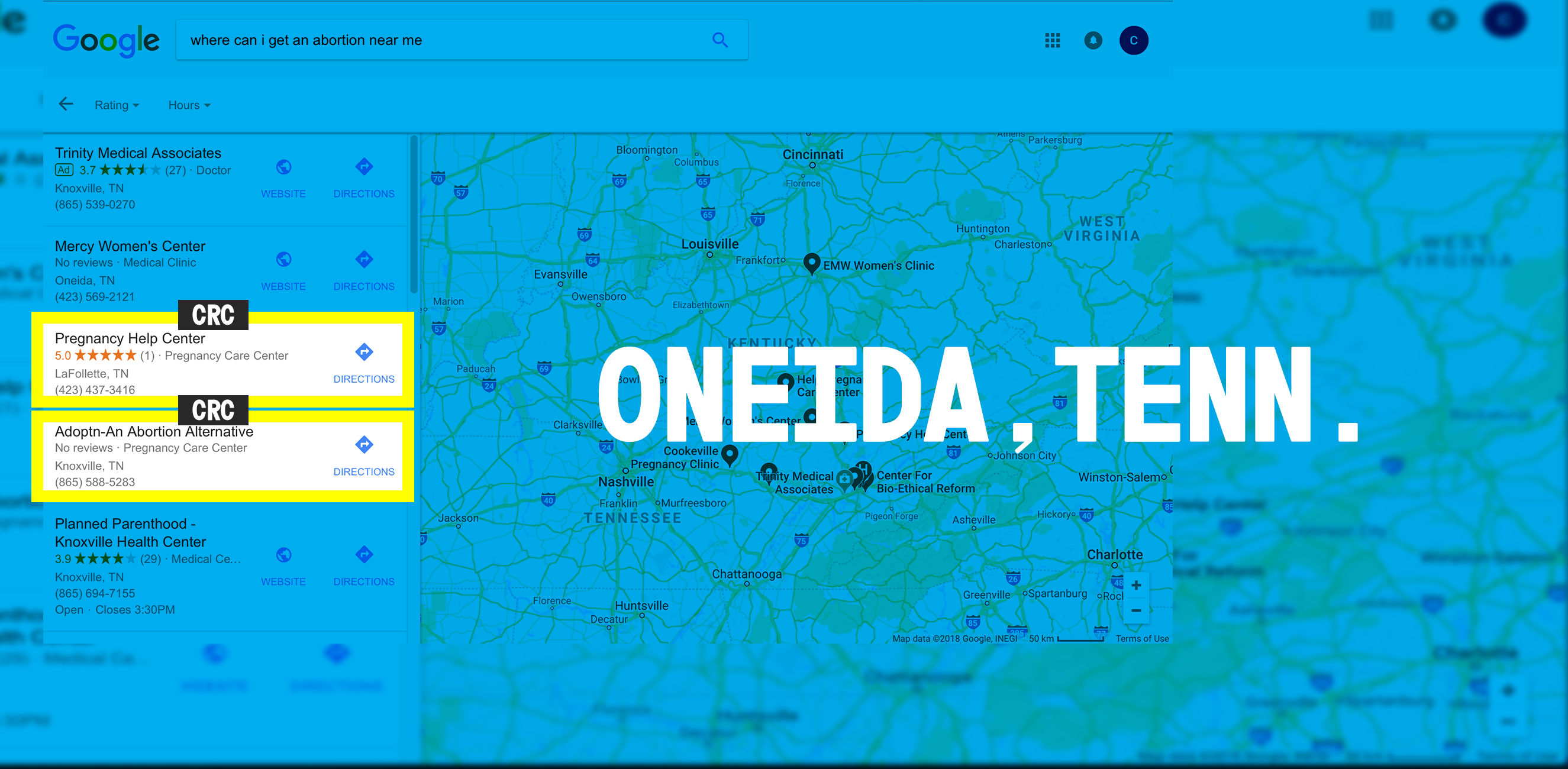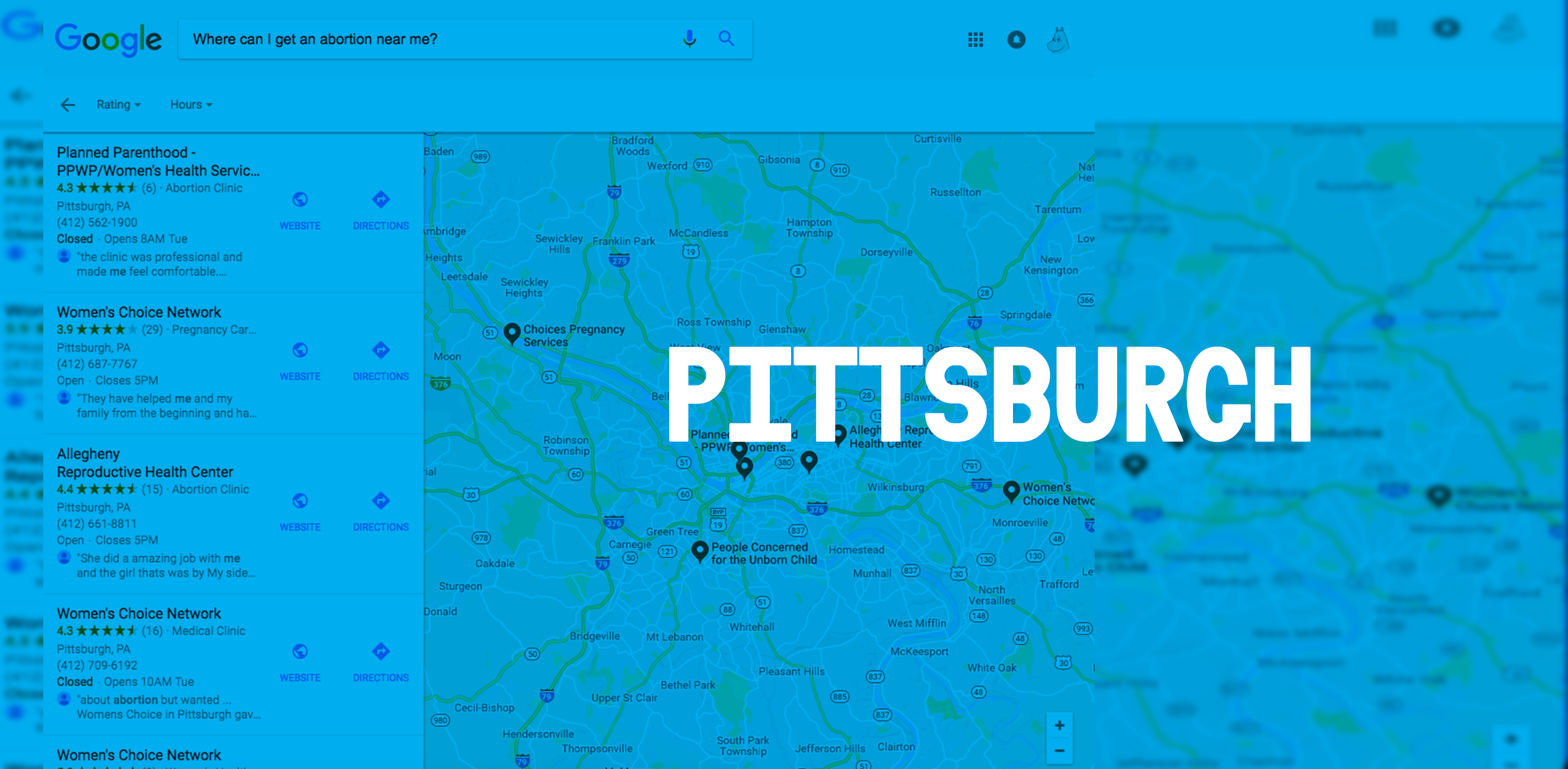Wrong Direction: Google Maps and Abortion
If you’re searching for abortion care, be careful using Google—you might end up at a crisis pregnancy center instead of a legit clinic. These centers, where staff pressures clients to “choose life,” have been gaming Google results at the local level using keywords and the maps function. Damn Joan and Gizmodo have partnered to investigate; read the technical side on their site and read what it’s like to visit a crisis pregnancy center below.
• • •
The three of us sat in the consultation room, waiting for the results of my pregnancy test.
I was joined by two counselors, both women—one in her 70s, and another, younger one, probably in her mid-40s. I’ll call them Karen and Linda. Karen had short gray hair and was wearing a sweater set. Linda was a redhead, dressed in what I would call business casual. She and I shared a shabby loveseat while Karen perched on a glider, the kind posh moms use for nursing. I wondered how long the test would take, but Linda was ready to go.
“If you are pregnant, what options are you considering?” she asked kindly.
I told her that I would probably be seeking an abortion. After all, the sign on this low-slung brick building across from a massive Kroger grocery store in Oak Ridge, Tennessee, said that we were in the Choices Resource Center.
Linda’s face tightened. “That’s not a decision to make lightly. It could have serious mental consequences,” she said, lifting her hands to her temples, as if to show me exactly where my remorse would take up permanent residence. “And there can be physical complications too.”
“God put this baby in your belly. He knows what he’s doing; he wants you to have this baby,” Karen added, nodding emphatically, her wrinkled eyes earnest.
“You’re 33,” said Linda. “Maybe this is your chance to become a mother.”
I placed a hand over my long-empty uterus.
“We’re here for you. We help so many girls like you,” Karen continued.
“God put this baby in your belly. He knows what he’s doing; he wants you to have this baby.”
Here’s the thing: I knew I wasn’t pregnant. I adhere piously to the church of Taking My Birth Control Every Damn Day. But as a woman living in Tennessee, in a rural notch of the Bible Belt where access to abortion care is severely restricted, I wanted to know what would happen if I ever needed to exercise my right to terminate a pregnancy. And as a journalist, I planned to write about what I discovered.
Abortion is legal, but there are still numerous laws aimed at preventing you from getting one. As of January 1, 2018, Tennessee requires that anyone seeking a termination must receive in-person counseling and wait 48 hours before the procedure can take place. That means you need to either live close enough to a clinic to make two trips, or be able to afford to take the time off work to travel to a clinic and stay for two nights.
I typed “pregnancy help near me” into Google and got only two results. The first, Mercy Women’s Clinic, was a dud; I called the number and learned it didn’t exist. The second hit, Life Choices, turned out to be a drug and alcohol treatment center.
Then I searched for “abortion nearby” on Google Maps. This was a more fruitful endeavor—most of the results were at least an hour away, but there were a lot to choose from: AA Women’s Services, Hope Resource Center, Pregnancy Care Center, and, of course, Choices Resource Center.
The number of results should have been a clue. In Tennessee, 96% of counties lack an abortion provider; there are only 11 in the state. According to the Abortion Care Network, there is exactly one independent abortion provider; the nearest Planned Parenthood to me is in Knoxville, 100 miles away. So what were all these clinics popping up when I was searching for an abortion?
These so-called crisis pregnancy centers [CPCs]—many of them taxpayer-funded and offering free services—pose as friendly, judgment-free places to discuss options and services, but really exist to try to coerce you into carrying a pregnancy to term. The lengths these places will go to entrap women are stunning: One chain (yes, there are chains) even changed the decor in every one of its clinics after it noticed that the “choice for life” rate went up in waiting rooms that had blue walls and comfortable furniture.
When I clicked through to some of the sites in my results, it was often hard to tell if they were CPCs or places that could really help. The generically named Hope Resource Center site notes that “Every woman facing an unplanned pregnancy has three options: parenting, adoption, or abortion,” but “does not perform or refer for abortion.” AA Women’s Services made its end goal pretty clear from the logo and slogan at the top: an infant’s footprints and, in huge cursive font, “every life deserves a lifetime.” I put myself in the shoes of someone in search of real help and cringed.
Damn Joan and Gizmodo asked women around the country to search for abortion care and send us their results. As you can see by clicking on the arrows above, in most cases Google suggested at least one anti-abortion crisis pregnancy center, carefully disguised amid legal abortion providers like Planned Parenthood. When presented with the results of our investigation, Google promised to look into the matter. Read more on Gizmodo. Map design: Lynda Lucas.
The abortion FAQ page on the Pregnancy Care Center site had a lot of misleading science, details cherry-picked from seemingly reliable sources and presented without context. There were claims like “Abortion carries the potential for physical complications, which are significant if they happen to you,” and that “Surgical and later-term abortions are also associated with an increased risk of emotional/psychological complications such as depression, anxiety, and relationship difficulties.” Quick fact-check: Women who had abortions didn’t experience more depression, anxiety, low self-esteem, or dissatisfaction with life than those who were denied it, and a first-trimester abortion is one of the safest medical procedures out there. Pregnancy Care Center’s site was set up to pressure and gaslight visitors whether they actually went to the physical center or not—and it wasn’t going to let facts get in the way.
Then I came to the Choices Resource Center. Despite the name, it seemed clear to me that it was a CPC, but I decided to find out for myself. I made an appointment for a pregnancy test the next day.
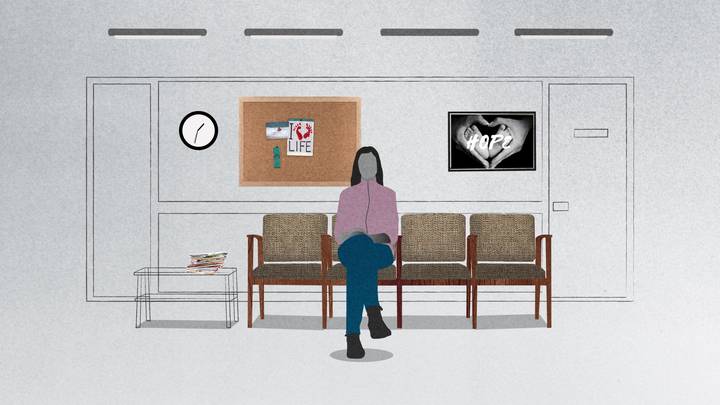
After a 90-minute drive through rural Tennessee, I pulled into the center’s parking lot. The building had the generic look of any medical facility: an ugly, rectangular, brown-brick building with a flat roof and a grid of tinted windows facing the street. Inside, the lobby was as agnostic as any doctor’s office—decorated with Pier 1 Imports art—and the waiting area was devoid of any other patients. Near the front desk, vaguely medical-looking brochures and pamphlets sat in stacks. On the end table, copies of a hunting magazine and Smithsonian were displayed to amuse bored patients.
Karen and Linda checked me in. Karen took my photo ID and photocopied it. Linda handed me a clipboard with forms to fill out. I didn't believe either of them was a health practitioner.
For not being a doctor’s office, and for providing the same basic test you’d buy at a drugstore, Choices Resource Center demanded a lot of personal info. It needed my name, my date of birth, and my address—plus that photocopy of my ID.
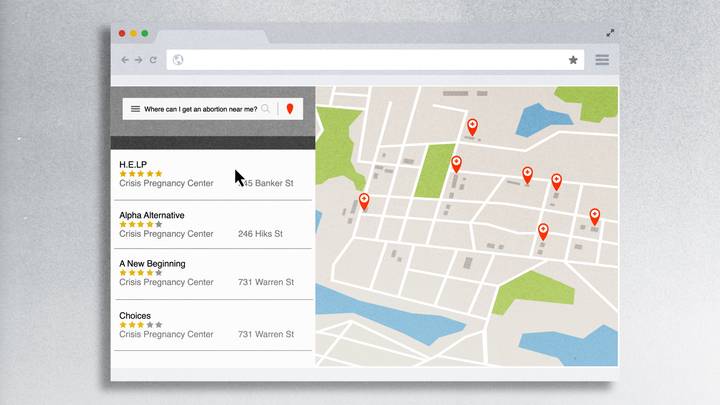
In small type, at the extreme bottom on the last page of the forms I had been given, I caught my first hint that Choices Resource Center was only fond of certain choices. “We do not make referrals to abortion clinics,” read the disclaimer. I was definitely in the wrong place.
Why didn’t I leave? I wanted to see it through, and I felt invested. Social scientists often talk about the “sunk costs” effect, which says that when you’ve invested some level of resources into something, you’re unlikely to abandon it, even if your gut tells you to. This is why we often sit through terrible movies. At this point, I’d driven more than an hour, surrendered my ID for copying, and filled out four pages of paperwork. I handed the clipboard back to Karen and smiled.
A young woman in pink scrubs called my name, handed me a plastic cup, and pointed toward a bathroom. “When you’re done, you can go sit in that room,” she said, motioning to a door down the hall. I followed her orders and made my way to the consultation room, where Linda was waiting. There was a cross on the wall.
“We’re here for you. We help so many girls like you.”
That’s where the two pressed me on my “options” before the test results were even in. They evoked pseudoscience and God; they kept referring to me, a woman in her mid-30s, as a girl. Just as I was preparing to respond to Karen, the woman in pink scrubs returned to inform us that my test was negative. “Oh, thank God,” I exhaled. Karen and Linda seemed almost disappointed. They’d psyched themselves up for a fight, but there was nothing to fight for. They didn’t care about me or my health—just the contents of my womb.
I walked out of the clinic somewhat stunned by what had transpired. There are few things more difficult to get in America than an abortion. I tried to imagine if there were this many barriers to buying Viagra. I tried to imagine this many barriers to buying a gun. I thought about the many women who’ve likely gone to Choices Resource Center over the years and been talked out of making what should be an informed choice about their own bodies.
I slid into my car and began the long drive home. I didn’t use Google Maps.
Ed. note: As a result of the Damn Joan/Gizmodo investigation, Google Communications Manager Liz Davidoff issued a statement, saying, “We're looking into the issues you've flagged. We strive for business results that are relevant, accurate and help users find what they're looking for.”
And in a chilling and enraging update: South Dakota’s state legislature has scheduled a hearing for February 13, 2018, on a bill that would obliterate the need for CPCs to interfere with maps results; it mandates that anyone seeking an abortion must visit a CPC before obtaining one, essentially ensuring that anti-abortion, anti-choice propaganda will be forced on those planning to have a legal, safe, medical procedure.
The author has requested anonymity; considering the violence of anti-abortion forces, we’re happy to provide it.
Story producer: Mikki Halpin; creative direction and lead animation: Felipe Posada; map design: Lynda Lucas; additional design and animation: Crosby Ignasher; music by: Fall On Your Sword; produced by Palmy Inn.
